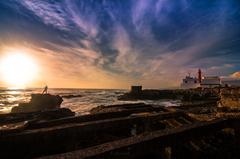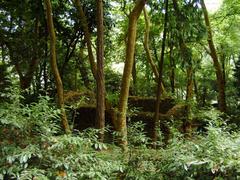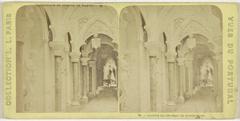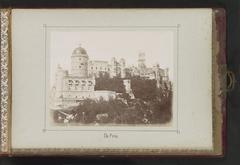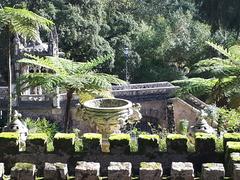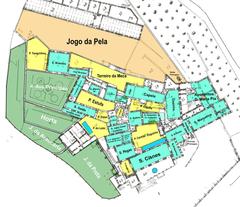Quinta dos Ribafria Visiting Hours, Tickets, and Guide to Sintra Historical Sites
Date: 14/06/2025
Introduction: Experience Sintra’s Renaissance Heritage
Quinta dos Ribafria, nestled in Sintra’s lush hills, is a captivating example of Renaissance and Manueline architecture with a history stretching back to the early 16th century. Built between 1536 and 1541 for Gaspar Gonçalves—a royal official favored by King Manuel I—the estate blends Renaissance symmetry, ornate Manueline stonework, and Mudéjar influences. Over the centuries, it has survived the 1755 Lisbon earthquake, served as a noble residence, and evolved into a vibrant cultural venue. Today, Quinta dos Ribafria offers visitors tranquil gardens, historic structures, and a robust cultural program, making it a must-see for those seeking Sintra’s hidden historical gems (Sintra Explorers Guide, Visit Sintra).
This guide provides everything you need for a memorable visit, including up-to-date hours, ticketing, accessibility tips, transportation, and highlights of nearby attractions. For the latest details, always check the Sintra Municipality website or Cultursintra Foundation.
Historical Overview
Origins and Noble Heritage
The land known as Herdade das Laranjeiras was granted to Gaspar Gonçalves by King Manuel I in 1515. Gonçalves, who became Lord of Ribafria in 1541, built the estate as a morgadio (entailed property), ensuring it remained within the family for generations. The Gonçalves family held the estate for nearly 200 years, shaping its legacy as a seat of Sintra’s local nobility.
Architectural Features
Quinta dos Ribafria is a showcase of:
- Renaissance and Manueline Styles: Harmonious symmetry, intricate stonework, and maritime motifs symbolic of Portugal’s Age of Discoveries.
- Tower and Defensive Elements: A square tower with crenellated battlements, reminiscent of medieval fortifications.
- Mudéjar Motifs: Decorative battlements and details influenced by Islamic architectural traditions.
- Gardens and Water Features: Geometric parterres, a large reflecting tank, a Renaissance fountain, and a vaulted cistern.
- Interiors: Coffered ceilings with painted motifs, religious and secular azulejo tiles, and chapels both indoors and in the surrounding woods (Guia da Cidade).
Ownership Changes and Restoration
After the Gonçalves era, the estate was sold in 1727 to Paulo de Carvalho de Ataíde, then passed to the Marquis of Pombal. Despite suffering damage in the 1755 earthquake, the estate preserved its historic character. In the 20th century, the Count of Cartaxo’s family restored significant portions. Since 2003, the Sintra Municipality has overseen the property, with management by the Cultursintra Foundation from 2015 onward.
Visiting Information
Opening Hours & Entry
- Gardens: Open Wednesday–Sunday, 10:00 AM–6:00 PM (extended to 7:00 PM in summer; closed on December 24, 25, 31, and January 1) (Visit Sintra).
- House Interior: Accessible only during special guided tours or by prior arrangement.
Admission:
- Gardens: Free entry.
- Guided house tours: Available for a modest fee; advance booking required.
Accessibility
- Gardens: Paved and mostly flat, suitable for wheelchairs and strollers.
- Historic House: Some areas have stairs and uneven floors; partial accessibility only.
- Contact the estate in advance for specific assistance requirements.
Getting There
- By Car/Taxi: 3 km from Sintra center, parking available on site.
- By Public Transport: Bus lines 434 and 435 connect Sintra’s train station and main attractions with stops near the estate.
- Walking: A scenic 25-minute walk from Sintra’s historic center.
Facilities
- Restrooms: Available on site.
- Food: No café; bring water and snacks.
- Picnics: Informal picnics are welcome in the gardens.
Visitor Experience
Atmosphere
Quinta dos Ribafria stands out for its peaceful, contemplative gardens and authentic historical ambiance. It is notably less crowded than Sintra’s headline attractions, making it a perfect retreat during high season (Sintra Explorers).
Events and Activities
The Cultursintra Foundation organizes regular cultural events, including:
- Sculpture exhibitions
- Concerts and open-air performances
- Festivals and community gatherings, especially in spring and summer
For the current schedule, check the official events page.
Nearby Attractions
Enhance your Sintra itinerary by pairing your visit with:
- Quinta da Regaleira
- Palácio Nacional de Sintra
- Moorish Castle
- Pena Palace
- Convent of the Capuchos (Sintra Explorers)
Sustainability and Preservation
Quinta dos Ribafria plays a vital role in Sintra’s sustainable tourism and cultural preservation efforts. The estate’s 13 hectares of gardens and woodland are maintained with ecological stewardship, and events often highlight environmental themes (Sintra Explorers).
Frequently Asked Questions (FAQ)
Q: What are the estate’s opening hours?
A: Gardens are open Wednesday–Sunday, 10:00 AM–6:00/7:00 PM, closed on major holidays.
Q: Is there an entry fee?
A: Gardens are free; guided tours of the house may require a fee.
Q: Is the estate accessible for visitors with reduced mobility?
A: Gardens are accessible; house interiors have limited access.
Q: Are guided tours available?
A: Yes, with advance booking or during special events.
Q: How do I get there by public transport?
A: Bus lines 434/435 from Sintra train station stop nearby.
Practical Tips for Visitors
- Best times: Spring and autumn for mild weather and fewer crowds.
- What to bring: Comfortable shoes, layered clothing, camera, water, and snacks.
- Photography: Allowed for personal use; professional shoots require permission.
Planning Your Visit
For up-to-date information on opening hours, events, and guided tours, visit:
- Sintra Municipality Official Site
- Cultursintra Foundation
- Official Quinta dos Ribafrias Page
- Sintra Explorers 2025 Guide
- Visit Sintra
- Guia da Cidade
Enhance your experience by downloading the Audiala app for guided audio tours and up-to-date information.
Summary
Quinta dos Ribafria invites visitors into a tranquil world of Renaissance beauty and noble history, with free access to its gardens, special events, and a growing cultural program. Its blend of heritage architecture, serene landscapes, and community spirit makes it a standout among Sintra’s historical sites. Whether you’re drawn by history, architecture, or the peaceful atmosphere, this estate is sure to enrich your Sintra adventure.

